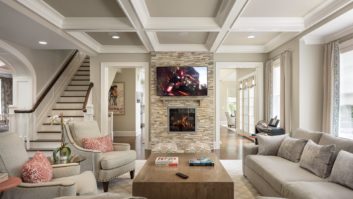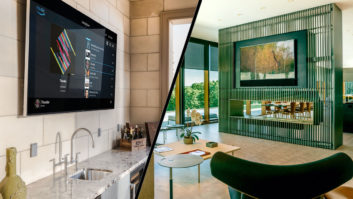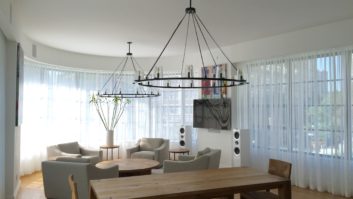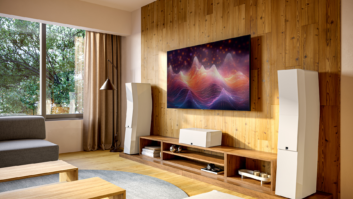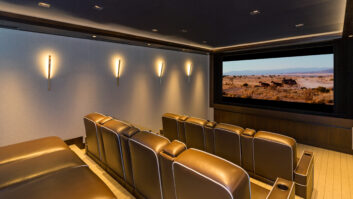I was blown away when Crestron released the Pyng Hub at CEDIA 2014. I viewed it as not only a great way to get systems up and running, but a prelude to being able to bring mid-market clients into the Crestron ecosystem. With a Pyng Hub, I was able to quickly and economically commission full lighting, shading, and HVAC systems in no time. A moderately trained tech can do the system commissioning and configuring (Pyng is not programming).
A few years ago, Crestron added audio to the Pyng hub with control for Sonos and Crestron audio matrix amps. This allowed clients to experience the next level of smart home technology by integrating environmental control with audio control. Starting with Pyng in 2014, I had some success getting clients hooked on smart home technology at a reasonable programming price point and have, over time, grown the majority of those systems into full-blown Crestron implementations with AV control and more advanced programming, but still maintain the Pyng ecosystem in the background. Adding in audio made it even more attractive to clients and made the upgrade path to audio control and distribution clearer, more enticing, and smoother.
Sonos integration has been a big hit with Crestron dealers since it launched and, with integration in Pyng, Crestron is seeing Sonos as a source on almost every distributed audio project, from Connects to Amps to Play speakers.

The Power of Pyng
Pyng has changed my business. Customers are happier. The power of Pyng is in their hands. If they want to make a change to a scene or a favorite TV channel, they can do it on their iPad, on the fly. We are not charging $300–800 to make a change, so customers don’t feel nickeled and dimed and I don’t feel like I’m nickel and diming them.
Plus, we are more efficient. I historically included small programming changes into service plans, so I was doing it for “free” anyways a lot of time. Now customers can do it themselves. They are empowered and don’t feel like they are putting me out every time they want to change something. And they aren’t waiting to make the change and getting frustrated that something isn’t working exactly as they want.
No more compiling and uploading huge programming files and waiting 10 to 20 minutes to test every change and tweak — everything we do is live as soon as we do it in the Pyng app, and we can do it anywhere we have internet access. Our techs are happier because they are doing more value-added work than just terminating wires and connecting equipment. They can now commission an entire system themselves, without a programmer.
Related: Blending Custom and Consumer
I can’t tell you how excited I am for Pyng OS 2. Dealers using Pyng have been waiting for this for a while — AV control. Now a video system can be easily configured from within the Pyng interface. Everything from TVs, settop boxes, Blu-ray players, Rokus, and Apple TVs to AVRs and audio streamers can be easily added with a few taps on an iPad. The Pyng processor is the CP3-R, and it includes everything you need to get anything from a single room to a full distribution system up and running. Just as with the original Pyng Hub and OS, Crestron infiNET EX, Cresnet, and partner devices (like Autonomic, Sonos, and ONVIF cameras) are easily discovered and added to the system. But now there is a “Third Party” category that includes five categories of product: AVRs, Blu-ray players, cable boxes, displays, and streaming players. So you not only get the ease of Pyng, but you still get the great reliability, support, and backing of Crestron and the quality of their hardware

Tap, Select, Tap, Select
Building an AV system is dead simple. Once the AV equipment is physically connected and all cabling is run, it takes less than an hour to get a full distributed audio system configured in Pyng. I could probably do it in 10 minutes for a single-room solution. All you do is use the the Pyng iPad App and enter the system setup:
- Click on Third Party Devices.
- Select the device category (AVR, cable box, streaming device, display, Blu-ray)
- Search for and select the brand
- Choose the model and control method
- Name the device (i.e., Dad’s Apple TV)
- Select the room or location where the device is located
- Assign the IR or Com port (serial) for control if using one of those protocols
- Go to Build System and click Select Source Routes
- Select the room and device you just created
- Map inputs and outputs by tapping an input on one device and selecting the corresponding output. (You can assign different audio and video paths, which is valuable for when using a distributed audio system or when downconverting HDMI audio to 2-channel from out of a DM into a SWAMP.)
All touch panels, mobile apps, and TSR (touchscreen remotes) are auto configured. For HR remotes, like the HR310, just go to the Customize screen, name the device button, and assign a device to that button. Pyng OS 2 will auto configure all necessary programming and macros to turn on devices, select inputs, and route audio and video signals — all without downloading or compiling a file. It happens live on the Pyng CP3-R and is live as soon as you tap.
Another benefit is that the configuration is available to anyone connected to the system, so there is no worry that a tech on-site adding a device down the road will have an outdated programming file or will not be able to access the configuration. It is all right there, natively on the Pyng processor, plus it is backed up automatically to mycrestron.com, so if there is ever a catastrophic failure, the configuration is easy accessible and downloadable.
Driver search is really easy, because the database is clean. Instead of populating the database with 25 new Sony TV drivers every year (five models x five sizes), there is one driver for the past several years that covers all Sony TVs made in that time. Multiply that by all of the display and Blu-ray manufacturers, and you can see how much cleaner and streamlined the database will be. Or, even better, just use CEC control, since it is a standard across the industry. There is one driver that covers all devices of that type with CEC control. No models to check, no compatibility issues. To steal a line from Steve Jobs, it just works. We are using CEC control on every TV we install now.

Playing Favorites
Does your client have favorite channels that they watch? To incorporate favorite channels, once a provider is selected for a cable box, favorite channels can be populated into Pyng. Not only are the channels and logos populated, but “now playing” and “up next” shows on the Pyng interface for the user. Their favorites are managed in the cloud, so if the provider makes a lineup change, it is all handled in the background by Crestron. No need to re-configure any of the favorites.
I’m sure mom has different favorites than little Billy. With Pyng OS 2, each family member can have their own Favorites list that they can customize themselves. They can add, edit, remove, and reorder favorites as they see fit, as often as they would like, with no need to call their integrator and pay programming fees. The client makes the change once in the Pyng interface, and all changes are propagated to every interface in the home — TSWs, TSRs, and mobile apps.
Pyng OS 2 supports all control methods: IR, IP, Serial, and CEC. If you can not find a device in the pre-populated Pyng interface, Crestron has an extensive library of drivers available. It is very easy to search the database and add any drivers required to your project. Just navigate to drivers.crestron.io and do a quick search. This is also a great resource to use prior to arriving on-site to ensure all legacy client components can be added to the system easily. In the instance where no drivers exist, you can always learn IR and Serial codes into OS 2 by using the SDK protocol for IR and Serial drivers.
And, finally, who doesn’t have a client asking about voice control. Pyng now integrates with Alexa, and the TSR remotes have a “push-to-talk” microphone. So no more screaming at the Echo Dot across the room, and you don’t have to use a “wake word” or say the room name, since Pyng knows what room the TSR remote is in. Integration is straightforward and gives home owners what they hear about and ask for. All in a simple to install and customize package.
A tech with basic training and understanding of AV can have a fairly complex media system with distributed audio and video in multiple zones programmed and running in under an hour. It will make your company more efficient and your clients happier.
